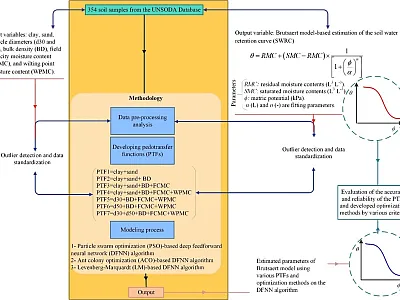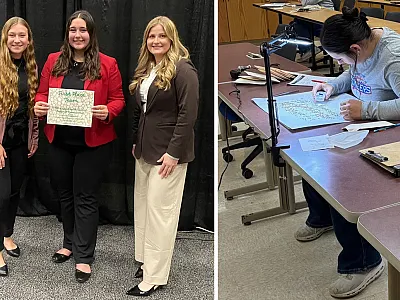Farming shallow histosols in South Florida
Impacts on crop production and strategies for soil conservation
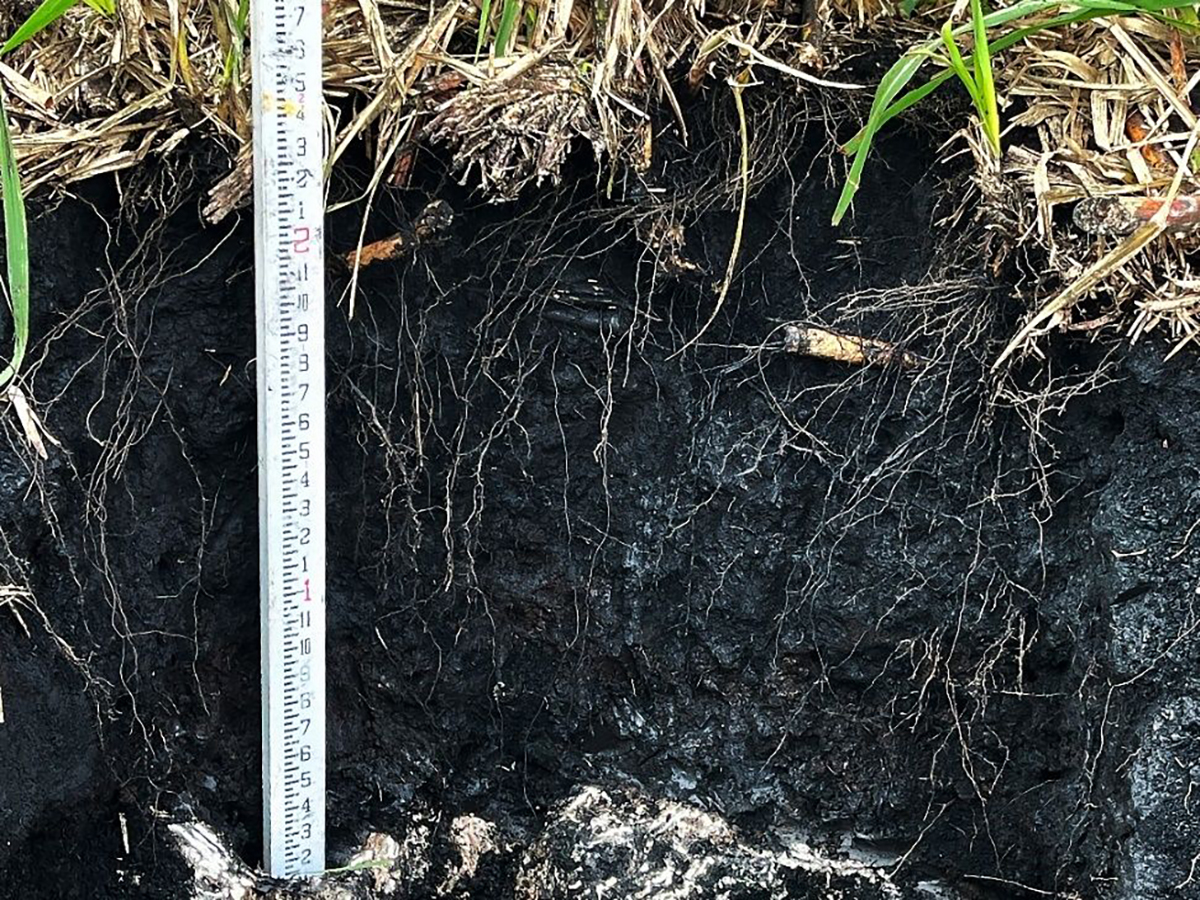

More than half of the U.S. sugarcane production comes from the Everglades Agricultural Area. The region’s high agricultural productivity is largely attributed to its fertile organic soils, Histosols, which contain up to 85% organic matter and provide essential nutrients for crop growth. However, decades of intensive farming coupled with hot and humid climate have led to significant soil loss. This article examines the impacts of farming on shallow organic soils in South Florida, exploring how reduced soil depth affects crop production and what strategies can help mitigate further soil loss. Earn 1 CEU in Soil & Water Management by taking the quiz.
More than half of the U.S. sugarcane production comes from the Everglades Agricultural Area (EAA) (Bai et al., 2024). However, since the early 1900s when the region was initially drained for farming, ongoing soil oxidation has led to steady loss of surface elevation, a process known as soil subsidence. This reduction in soil depth not only limits the reservoir of organic matter (OM) that supplies essential nutrients for crop growth but also weakens the physical support for root systems, raising serious concerns among farmers about the long-term sustainability of agriculture in the region.
Under drained conditions, multiple factors contribute to soil subsidence, including oxidation, shrinkage (above the water table), consolidation (below the water table), compaction from machinery and tillage, wind and water erosion, and burning (Pronger et al., 2014). Among these, oxidation is the dominant cause, accounting for approximately 75% of total soil losses (Stephens and Speir, 1970). As organic soils are lost and become shallow over time, they become increasingly vulnerable to flooding due to the impermeable limestone bedrock beneath them, which limits natural drainage. Additionally, the loss of soil depth reduces nutrient availability, water retention, and root space, directly threatening sugarcane production and long-term agricultural viability in the EAA. This dual challenge of soil loss and rising flood risks necessitates proactive soil conservation and adaptive management strategies to sustain crop yields and maintain environmental stability.
This article examines the impacts of farming on shallow organic soils in South Florida, exploring how reduced soil depth affects crop production and what strategies can help mitigate further soil loss. By implementing soil conservation techniques such as flooded rice as a rotational crop with sugarcane, best management practices (BMPs), and improved water management, farmers can work toward preserving soil health and long-term sustainability of agriculture in the EAA.
Shallow soils in South Florida
The formation of Histosols began approximately 3,200 years ago as wetland vegetation accumulated under saturated conditions (Wanless et al. 1994), preserving OM from decomposition due to limited oxygen availability. This process resulted in an average peat accumulation rate of 0.03 inches/year (McDonwell, 1969). However, following the initial drainage of the EAA, rapid subsidence occurred at a rate of 3.54 inches/year, primarily due to soil shrinkage from drying and the loss of buoyant support from water (Stephens, 1956).
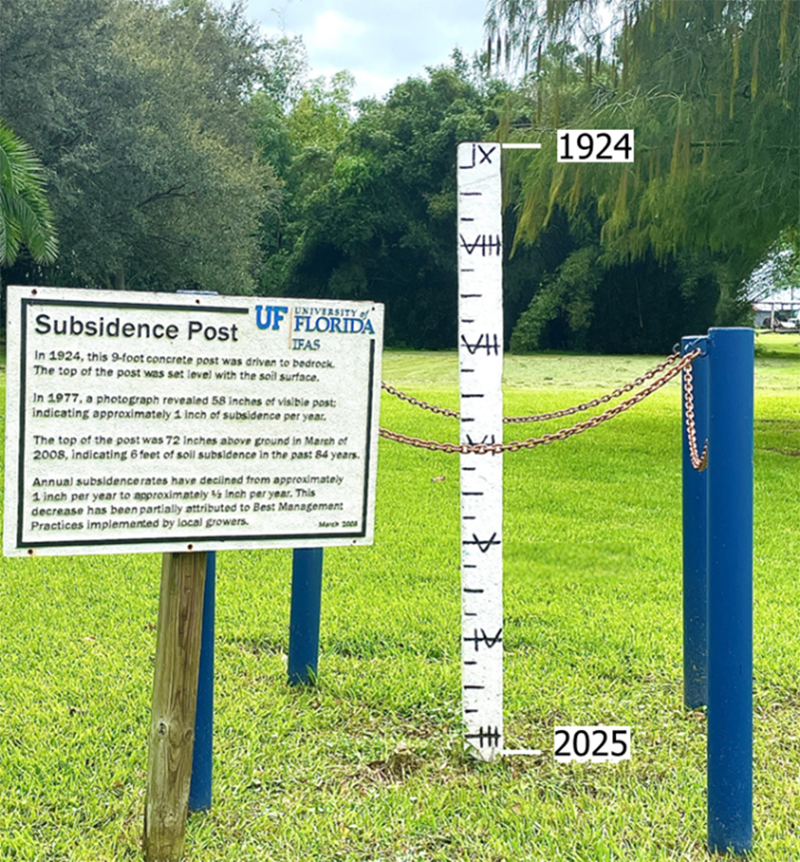
As cultivation began, subsidence stabilized at approximately 1.18 inches/year, driven largely by the oxidation of OM (Stephens, 1956; Stephens and Speir, 1970). In recent decades, subsidence rates have declined further to 0.57 inches/year (Shih et al., 1998) and currently stand at 0.26 in/year (Rodriguez et al., 2020). This reduction in soil loss is attributed to factors such as higher water tables—potentially influenced by best management practices, along with increased soil mineral content and the accumulation of recalcitrant organic carbon (Shih et al., 1998; Galloway et al., 1999; Bhadha et al. 2020). A concrete post was installed in 1924 at the Everglades Research and Education Center to document soil loss, and nearly 75 inches of soil has been lost to date (Figure 1).
Since the classification of Histosols in the EAA is partly based on depth from the underlying limestone bedrock, soil series in the region have undergone changes with a continuous decrease in soil thickness over past decades. Figure 2 depicts the changes in distribution in the Histosol series in the EAA between 1973 and 2024. Compared with 1973, around 15% of Pahokee muck (36–51 inches) in the southern EAA has subsided, changing the soil classification to the shallower Lauderhill muck (20–36 inches) soil series.
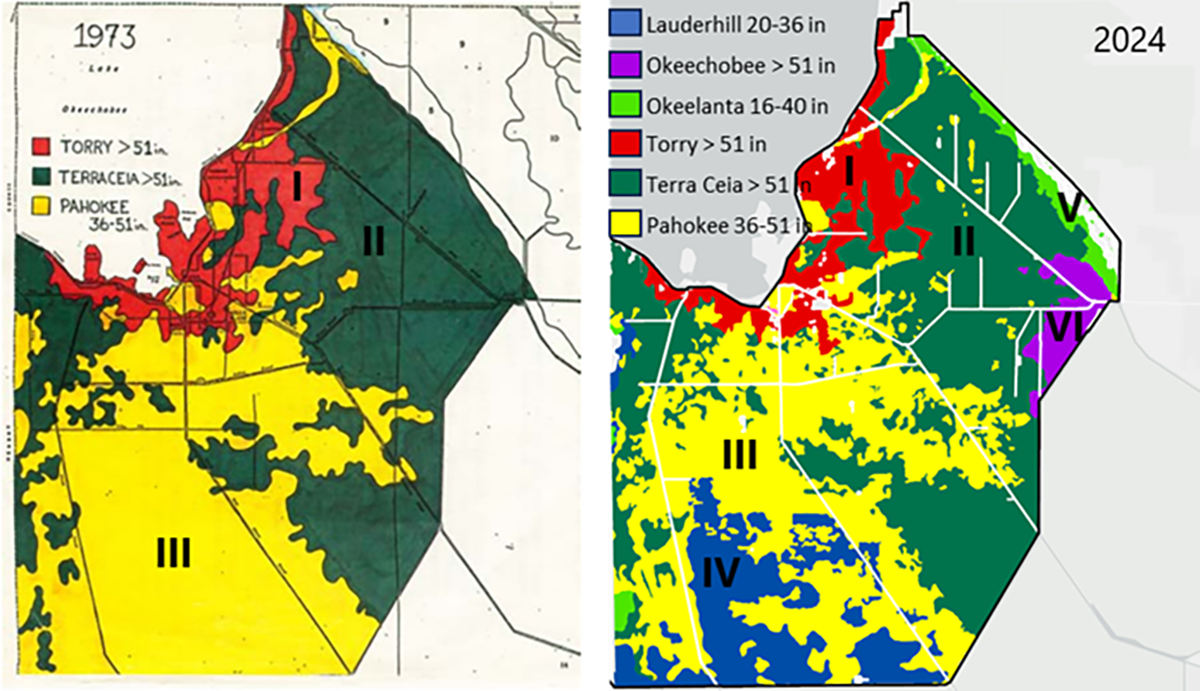
Impacts of soil loss on crop production
Soil loss generally leads to a reduction in nutrients, water availability, and root space for crop growth, ultimately leading to lower yields (Gomiero, 2016). However, in the EAA, the ample availability of nutrients and water in the region, coupled with advancements in agricultural technologies such as stringent soil testing for nutrient recommendations and effective plant breeding address the constraints posed by shallow soils. As a result, the soil depth threshold at which yield declines becomes undetectable (Bai et al., 2024).
Despite a significant reduction in soil thickness over the past century, sugarcane production in the EAA has continued to rise. This resilience can be attributed in part to strategic genetic improvements with more than 130 sugarcane cultivars introduced since 1920 (Figure 3), enhancing productivity under increasingly constrained soil conditions (Bai et al., 2024). However, if the current rate of soil depletion persists, the long-term sustainability of farming in the region may be at risk. While short-term adaptations have enabled continued production, an eventual tipping point could lead to a decline in crop viability.
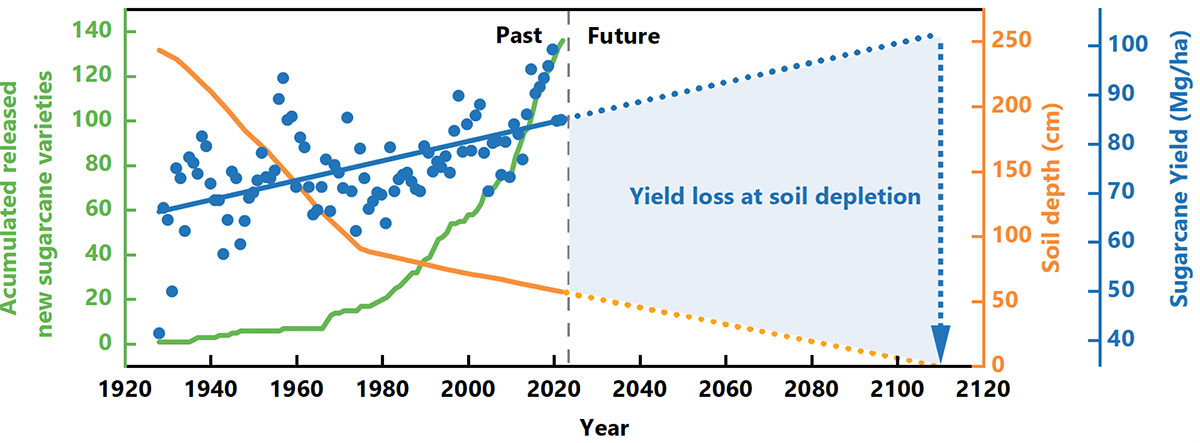
Beyond the direct impact on agricultural productivity, ongoing soil subsidence of Histosols exacerbates hydrological challenges, particularly in the context of sea-level rise. As elevation loss continues, the risk of flooding increases, threatening both crop fields and regional water management infrastructure. Continued research and adaptive management strategies will be crucial in mitigating the impact of soil degradation while maintaining the economic and environmental sustainability of the EAA.
Strategies for soil conservation
Conservation tillage
Both conservation and conventional tillage are common practices used to prepare land before planting cash crops, but they differ in their impact on soil disturbance. Conventional tillage, also known as intensive tillage, involves excessive soil disruption and drainage, which exposes organic soil to microbial activity (Figure 4). This accelerates the microbial mineralization of OM, leading to soil subsidence in the EAA.
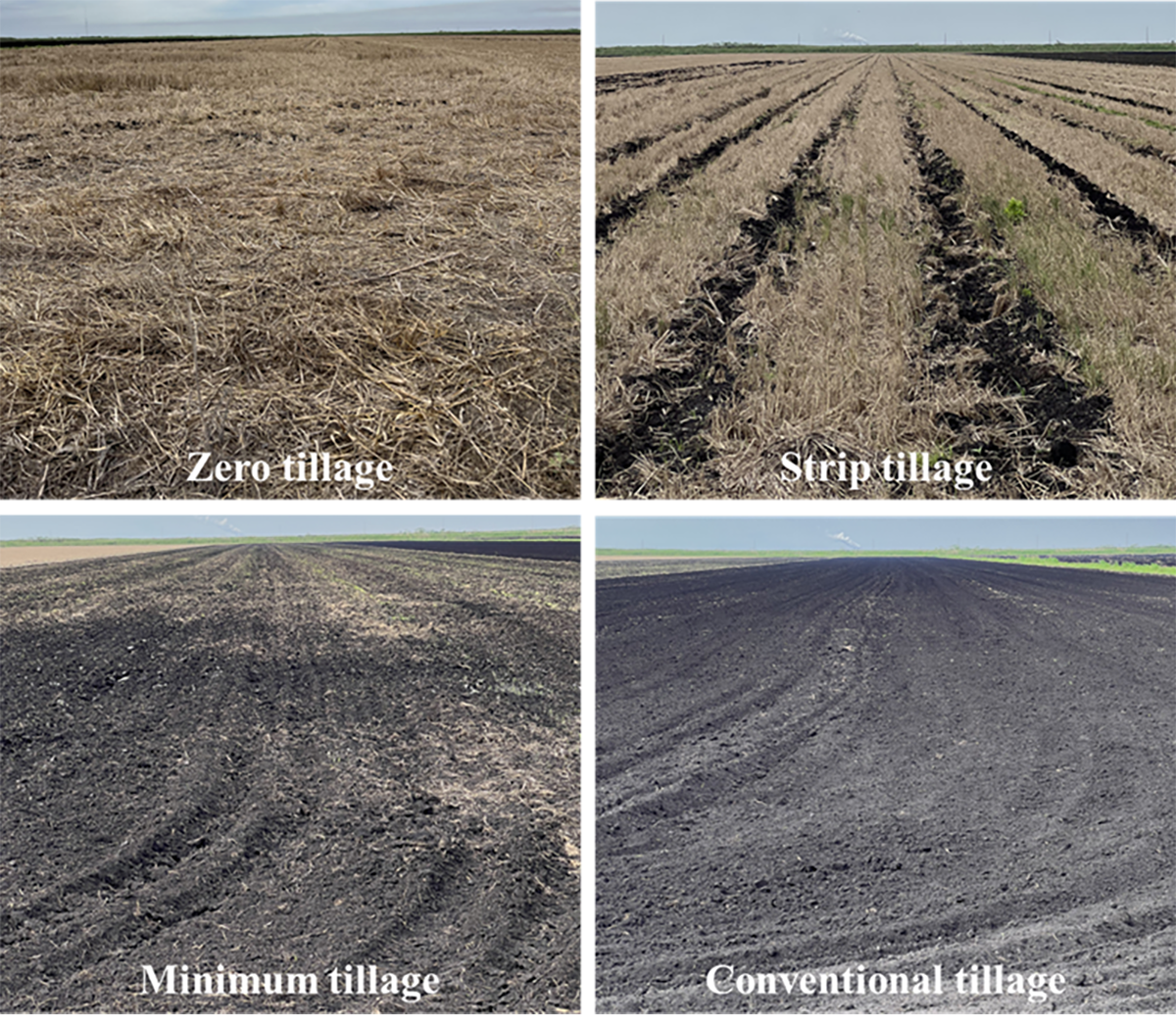
In contrast, conservation tillage minimizes soil disturbance by retaining crop residues on the surface (Busari et al., 2015) and employing reduced tillage techniques such as zero, strip, or minimum tillage (Figure 4). These practices help conserve organic soil by reducing its exposure to microbial decomposition, thereby slowing OM oxidation (Gambolati et al., 2005). Additionally, conservation tillage enhances soil health and fertility by increasing OM input into the soil system (Düring et al., 2002; Ecoworld, 2024). Another key benefit of conservation tillage is its role in improving soil aggregation and forming macro-aggregates, which help mitigate soil loss due to wind erosion (Weidhuner et al., 2020). This is particularly beneficial in the hot summer months when dry, fine soil particles are more prone to being blown away by wind.
Cover crops
Cover crops (CCs) are non-cash crops, typically grasses, legumes, or other plant species, grown after the harvest of commercial crops to protect and cover the soil during fallow periods. In the EAA, high summer temperatures and excessive evaporation lead to extremely dry soil conditions, particularly just before the rains, accelerating microbial mineralization of OM and increasing susceptibility to wind erosion.
By maintaining soil cover, CCs help prevent soil loss from wind erosion (Nancy and Keith, 2019) while also cooling the soil (Blanco‐Canqui et al., 2015). This cooling effect reduces microbial activity and slows OM decomposition. Additionally, CCs contribute to soil OM accumulation by capturing atmospheric carbon through photosynthesis and incorporating it into the soil when the plants decompose (Nancy and Keith, 2019). The OM accumulation not only mitigates soil loss but also helps soils to (1) retain more water during rainy season and supply it to the crop during dry season; (2) retain plant nutrients, thereby preventing nutrient leaching; and (3) improve soil structure, a building block that controls water and nutrient movement in the soil systems.
Additional benefits of CCs include suppressing weeds, providing habitat for beneficial predatory insects, and facilitating crop pollinators. They can also add new nitrogen to the soil by biologically fixing it from the air and can recycle nutrients by assimilating nutrients that were supposed to leach out during fallow periods, releasing them to the next cash crops once CC residues are incorporated into the soils.
In the EAA, common summer cover crops such as sorghum sudangrass, sunn hemp (Figure 5), buckwheat, Japanese millet, foxtail millet, pearl millet, cowpeas, and bush green beans (Nancy & Keith, 2019) serve as effective conservation strategies. These crops are well adapted to the region's hot summer climate and can germinate successfully under high temperatures, making them a sustainable solution for mitigating organic soil loss in the EAA (Bhadha et al., 2021).
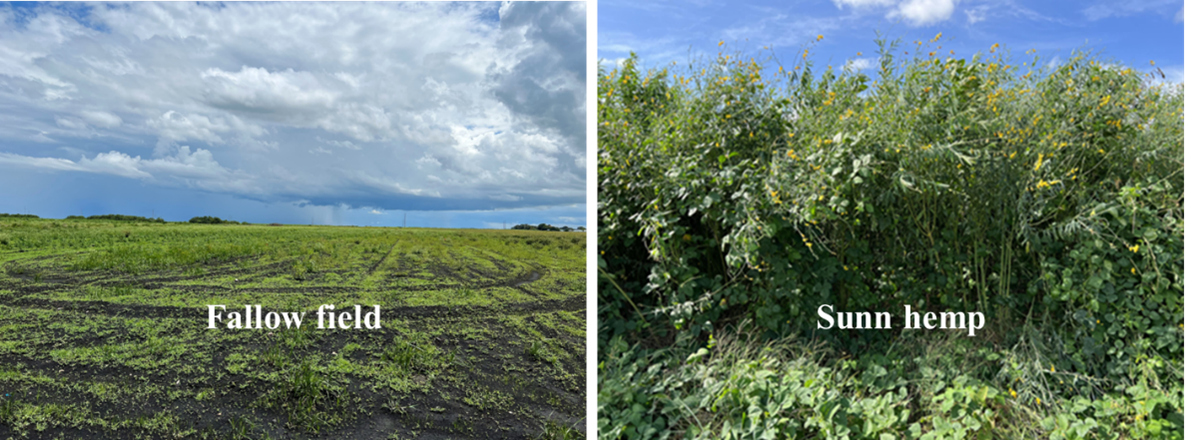
Recycle bagasse
Bagasse is a dry, fibrous residue obtained after extracting sugar juice from sugarcane that can be strategically recycled to conserve shallow organic soils (Figure 6). For every ton of sugarcane milled, approximately 551–617 lb of bagasse is produced (Michailos et al., 2016). On average, the sugarcane industry in South Florida produces around 2.8–5.5 million tons of bagasse (Bhadha et al., 2020), depending on the sugarcane production.
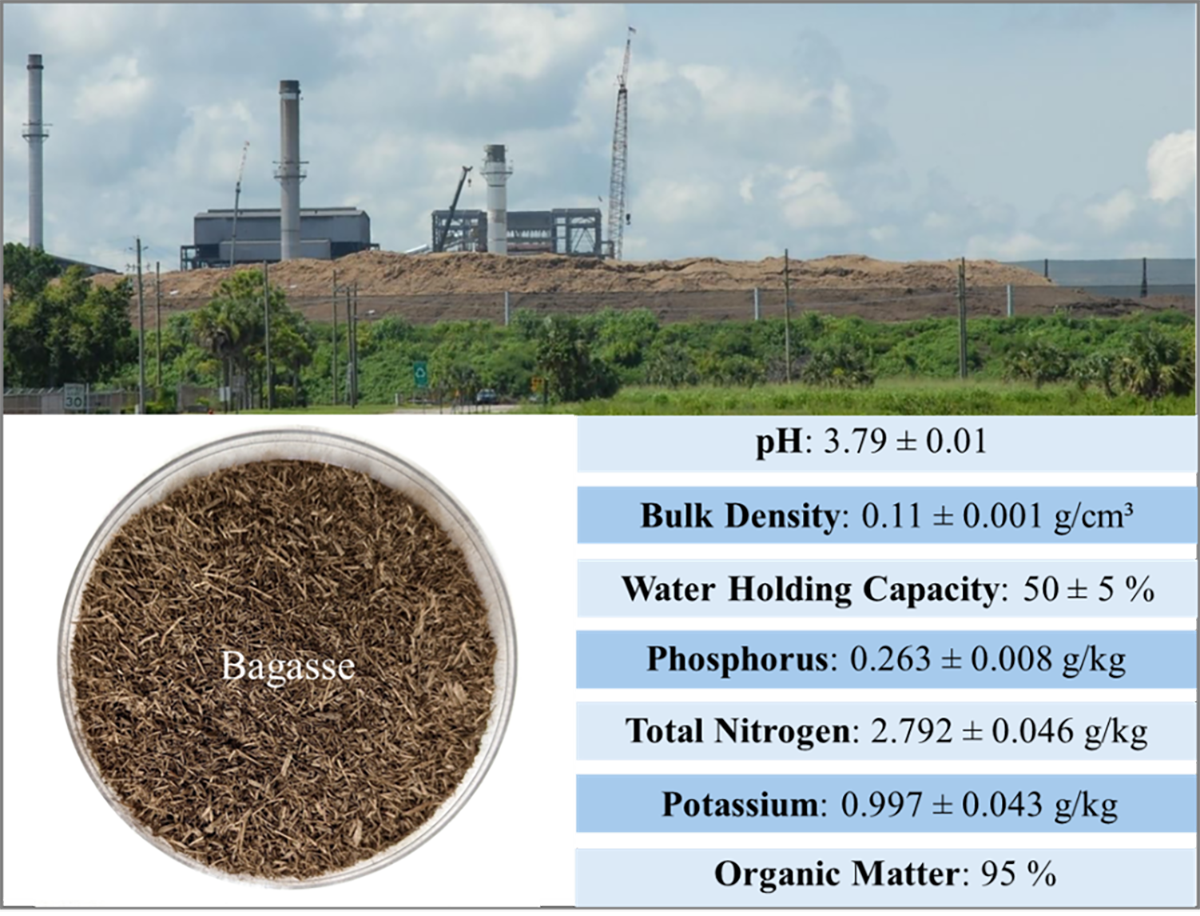
Bagasse serves as a valuable soil amendment when incorporated back into the field. Studies have shown that recycling bagasse can enhance soil OM and water-holding capacity while stimulating beneficial soil microorganisms that improve nutrient cycling (Dotaniya et al., 2013). The fibrous structure of bagasse also aids in reducing soil erosion by wind and water, a crucial factor in the shallow organic soils of the South Florida (Danso et al., 2015).
Although residue incorporation can increase labile carbon (e.g., fatty acids, proteins, and polysaccharides) (Paul et al., 2006), burning sugarcane before harvest is common practice in the organic soils of South Florida, thereby limiting the organic residues available to enrich the soil (Gilbert et al., 2010). Shifting from widespread burning to recycling residues like bagasse could significantly promote soil health, reduce oxidation-induced soil loss, and enhance long-term productivity.
Water level management
Water table depth is a key factor in controlling soil subsidence as it regulates peat growth and formation (Ma et al., 2022; Nusantara et al., 2018; Carlson et al., 2015). High water tables reduce carbon oxidation to CO₂, whereas lower water tables accelerate microbial metabolism, leading to increased OM decomposition and volatilization (Tate, 1979). Previous studies on soil subsidence in the EAA have shown a strong relationship between water table levels and subsidence rates. Snyder et al. (1978) reported that halving the water table depth doubled the rate of soil subsidence. Similarly, Hu et al. (2017) found a negative correlation between cumulative CO₂ emissions and the number of days EAA peats remained flooded.
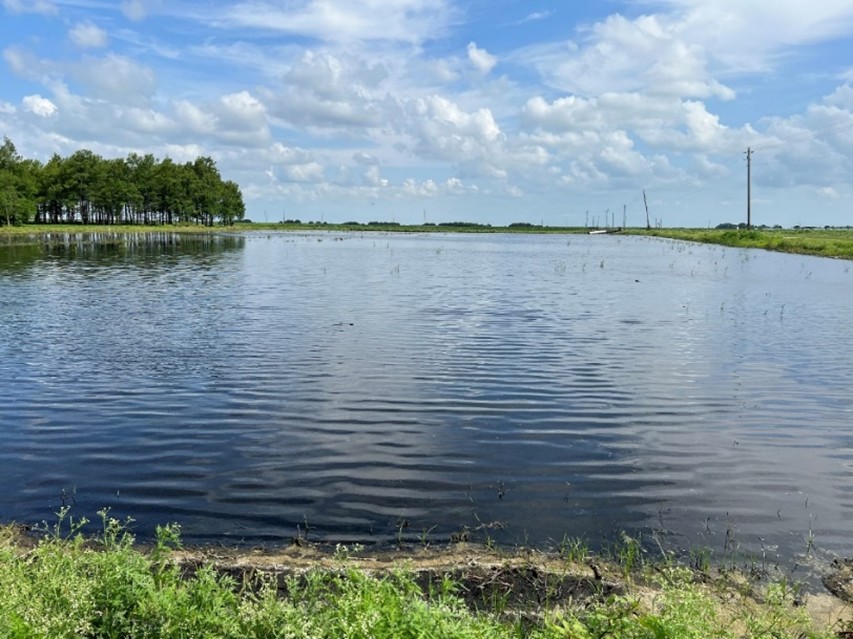
Sugarcane can tolerate relatively high water tables (Glaz & Lingle, 2012). A three- to four-month cycle of flooding and draining during the summer has been recommended to raise water tables without affecting sugarcane yields while reducing soil subsidence in the EAA (Glaz & Morris, 2010) (Figure 7). However, short flood cycles (e.g. two days of flooding followed by 12 days of draining) have been found to accelerate OM oxidation compared with continuously drained soils, increasing soil subsidence rates, and should therefore be avoided (Rodriguez et al., 2021).
Flooded rice rotation
Some EAA farms flood their soil either as flooded fallow for pest control or to grow flooded rice during summer period (Figure 8). Integrating rice cultivation provided both agronomic and environmental benefits. The raised water level in rice fields addresses this challenge of soil subsidence by maintaining saturated conditions, reducing oxygen penetration, and slowing the decomposition of soil OM. Flooded conditions during rice production suppress weeds, reduce pest populations such as wireworms, and eliminate the need for soil insecticides. Furthermore, rice improves soil health, conserves nutrients, and enhances the productivity of subsequent sugarcane crops (Bhadha et al., 2018). Rice production also diversifies growers' incomes and sustains employment during the summer off-season.
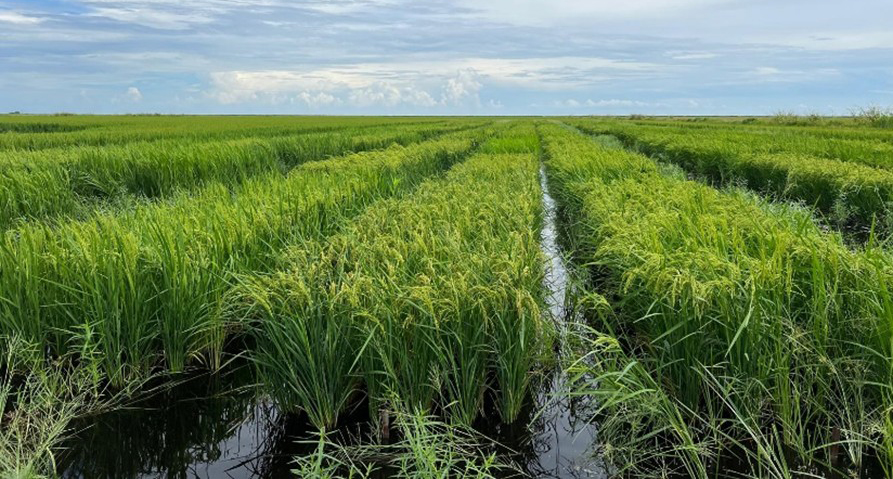
Rice acreage in the EAA has expanded significantly, from 11,912 acres in 2008 to 23,058 acres in 2024, reflecting its growing recognition as both a valuable crop and a conservation tool (Bhadha et al., 2024). However, challenges remain, including efficient irrigation management and reliance on rice varieties bred in other states. Ongoing research, such as variety trials by UF/IFAS and local growers, continues to introduce high-yielding, disease-resistant strains. Establishing water-related stakeholder collaboration and developing data-driven decision-making tools (Smidt et al., 2023) are essential to further strengthening flooded rice rotation as a cornerstone of sustainable agriculture in South Florida.
Conclusion
Sustaining agriculture in the EAA requires proactive soil conservation strategies to mitigate subsidence and maintain productivity. Cover crops, flooded rice rotations, improved water management, conservation tillage, and organic residue recycling have proven to be effective in reducing OM loss, enhancing soil health, and supporting long-term sugarcane production. While challenges remain, continued research, stakeholder collaboration, and adaptive management will be key to ensuring the future sustainability of agriculture in South Florida.
Bai, X., Li, Y., Manirakiza, N., Coffin, C., & Bhadha, J. H. (2025). Histosols of South Florida: Past, present, and future. EDIS, 2025, SL527.
Bai, X., Smidt, S. J., Fan, Y., Brophy, T., Her, Y. G., Manirakiza, N., ... & Bhadha, J. H. (2024). Farming shallow soils: impacts of soil depth on crop growth in the Everglades agricultural area of Florida, USA. Field Crops Research, 316, 109523.
Bhadha, J. H., Khatiwada, R., Galindo, S., Xu, N., & Capasso, J. (2018). Evidence of soil health benefits of flooded rice compared to fallow practice. Sustainable Agriculture Research, 7(4), 31–41.
Bhadha, J. H., Trotta, L., Cavazos, D., & VanWeelden, M. (2024). Trends in Florida rice production and varieties. EDIS, 2024, SL439/SS653.
Bhadha, J. H., Wright, A. L., & Snyder, G. H. (2020). Everglades Agricultural Area soil subsidence and sustainability. EDIS, 2020, SL 311/SS523.
Bhadha, J. H., Xu, N., Khatiwada, R., Swanson, S., & LaBorde, C. (2020). Bagasse: a potential organic soil amendment used in sugarcane production. EDIS, 2020, SL477/SS690.
Bhadha, J. H., Xu, N., Rabbany, A., Amgain, N. R., Capasso, J., Korus, K., & Swanson, S. (2021). On-farm soil health assessment of cover-cropping in Florida. Sustainable Agriculture Research, 10(2), 17–32.
Bhatt, R., & Khera, K. L. (2006). Effect of tillage and mode of straw mulch application on soil erosion in the submontaneous tract of Punjab, India. Soil and Tillage Research, 88(1-2), 107–115.
Blanco‐Canqui, H., Shaver, T. M., Lindquist, J. L., Shapiro, C. A., Elmore, R. W., Francis, C. A., & Hergert, G. W. (2015). Cover crops and ecosystem services: Insights from studies in temperate soils. Agronomy Journal, 107(6), 2449–2474.
Busari, M.A., Kukal, S.S., Kaur, A., Bhatt, R., Dulazi, A.A., (2015). Conservation tillage impacts on soil, crop and the environment. International Soil and Water Conservation Research, 3(2), pp.119–129.
Carlson, K. M., Goodman, L. K., & May-Tobin, C. C. (2015). Modeling relationships between water table depth and peat soil carbon loss in Southeast Asian plantations. Environmental Research Letters, 10(7), 074006.
Cox, S., Lewis, D., McCollum, S., Bledsoe, M., & Marrotte, R. (1988). Subsidence study of the Everglades agricultural area. USDA, Soil Conservation Service, Greenacres, FL.
Danso, H., Martinson, D. B., Ali, M., & Williams, J. B. (2015). Effects of sugarcane bagasse fibre on the strength properties of soil blocks. First International Conference on Bio-Based Building Materials.
Dotaniya, M. L., Datta, S. C., Biswas, D. R., Dotaniya, C. K., Meena, B. L., Rajendiran, S., ... & Lata, M. (2016). Use of sugarcane industrial by-products for improving sugarcane productivity and soil health. International Journal of Recycling of Organic Waste in Agriculture, 5, 185–194.
Dotaniya, M. L., Sharma, M. M., Kumar, K., & Singh, P. P. (2013). Impact of crop residue management on nutrient balance in rice-wheat cropping system in an Aquic hapludoll. Journal of Rural and Agricultural Research, 13(1), 122–123.
Düring, R. A., Hoß, T., & Gäth, S. (2002). Depth distribution and bioavailability of pollutants in long-term differently tilled soils. Soil and Tillage Research, 66(2), 183–195.
Ecowworld. 2024. How conservation tillage practices improve soil health and boost yields. https://ecowworld.com/conservation-tillage-benefits-soil/
Galloway, D. L., Jones, D. R., & Ingebritsen, S. E. (Eds.). (1999). Land subsidence in the United States (Vol. 1182). USGS.
Gambolati, G., Putti, M., Teatini, P., Camporese, M., Ferraris, S., Stori, G. G., ... & Tosi, L. (2005). Peat land oxidation enhances subsidence in the Venice watershed. Eos, Transactions American Geophysical Union, 86(23), 217–220.
Gilbert, R. A., Kingston, G., Morgan, K., Rice, R. W., Baucum, L., & Shine, J. M. (2010). Effect of harvest method on microclimate and sugarcane yield in Florida and Costa Rica. Proceedings of the International Society of Sugar Cane Technology, 27, 1–10.
Glaz, B., & Lingle, S. E. (2012). Flood duration and time of flood onset effects on recently planted sugarcane. Agronomy Journal, 104(3), 575–583.
Glaz, B., & Morris, D. R. (2010). Sugarcane responses to water‐table depth and periodic flood. Agronomy journal, 102(2), 372–380.
Gomiero, T. (2016). Soil degradation, land scarcity and food security: Reviewing a complex challenge. Sustainability, 8(3), 281.
Hu, J., VanZomeren, C. M., Inglett, K. S., Wright, A. L., Clark, M. W., & Reddy, K. R. (2017). Greenhouse gas emissions under different drainage and flooding regimes of cultivated peatlands. Journal of Geophysical Research: Biogeosciences, 122(11), 3047–3062.
Ma, L., Zhu, G., Chen, B., Zhang, K., Niu, S., Wang, J., ... & Zuo, H. (2022). A globally robust relationship between water table decline, subsidence rate, and carbon release from peatlands. Communications Earth & Environment, 3(1), 254.
McDowell, L. L., Stephens, J. C., & Stewart, E. H. (1969). Radiocarbon chronology of the Florida Everglades peat. Soil Science Society of America Journal, 33(5), 743–745.
Michailos, S., Parker, D., & Webb, C. (2016). Simulation studies on ethanol production from sugar cane residues. Industrial & Engineering Chemistry Research, 55(18), 5173–5179.
Morris, D. R., Gilbert, R. A., Rainbolt, C. R., Perdomo, R. E., Powell, G., Eiland, B., & Montes, G. (2007). Sugarcane yields and soil chemical properties due to mill mud application to a sandy soil. Proceedings of the International Society of Sugar Cane Technology, 26, 444–448.
Nancy, C., & Keith, B. (2019). Summer cover crops. North Carolina State Extension Publications.
Nusantara, R. W., Hazriani, R., & Suryadi, U. E. (2018). Water-table depth and peat subsidence due to land-use change of peatlands. In IOP Conference Series: Earth and Environmental Science (Vol. 145, No. 1, p. 012090). IOP Publishing.
Paul, E. A., Morris, S. J., Conant, R. T., & Plante, A. F. (2006). Does the acid hydrolysis-incubation method measure meaningful soil organic carbon pools? Soil Science Society of America Journal, 70(3), 1023–1035. https://doi.org/10.2136/sssaj2005.0103
Pronger, J., Schipper, L. A., Hill, R. B., Campbell, D. I., & McLeod, M. (2014). Subsidence rates of drained agricultural peatlands in New Zealand and the relationship with time since drainage. Journal of Environmental Quality, 43(4), 1442–1449.
Qureshi, M. E., Wegener, M. K., & Mallawaarachchi, T. (2001). The economics of sugar mill waste management in the Australian sugar industry: Mill mud case study. 45th Annual Conference of the Australian Agricultural and Resource Economics Society, Adelaide, South Australia.
Rodriguez, A. F., Daroub, S. H., Gerber, S., Jennewein, S. P., & Singh, M. P. (2021). Water management effect on soil oxidation, greenhouse gas emissions, and nitrogen leaching in drained peat soils. Soil Science Society of America Journal, 85(3), 814–828.
Shih, S. F., Glaz, B., & Barnes, R. J. (1998). Subsidence of organic soils in the Everglades Agricultural Area during the past 19 years. Soil and Crop Science Society of Florida Proceedings, 57, 20–29
Smidt, S. J., Haacker, E. M. K., Bai, X., Cherkauer, K., Choat, B., Crompton, O., ... & Zoccatelli, D. (2023). Forming the future of agrohydrology. Earth's Future, 11(12), e2022EF003410
Snyder, G. H., Burdine, H. W., Crockett, J. R., Gascho, G. J., Harrison, D. S., Kidder, G., ... & Shih, S. F. (1978). Water table management for organic soil conservation and crop production in the Florida Everglades (Bull. 801). University of Florida/IFAS Agricultural Experiment Station.
Stephens, J. C. (1956). Subsidence of organic soils in the Florida Everglades. Soil Science Society of America Journal, 20(1), 77–80.
Stephens, J. C., & Speir, W. H. (1970). Subsidence of organic soils in the USA. In Symposium on Land Subsidence, International Association of Scientific Hydrology, Tokyo (pp. 523–534).
Tate, R. L. (1979). Effect of flooding on microbial activities in organic soils: carbon metabolism. Soil Science, 128(5), 267–273. https://doi.org/10.1097/00010694-197911000-00002
Wanless, H. R., Parkinson, R. W., & Tedesco, L. P. (1994). Sea level control on stability of Everglades wetlands. In S. Davis and J.C. Ogden (Eds.), Everglades: the ecosystem and its restoration. St. Lucie Press.
Weidhuner, A., Hanauer, A., Krausz, R., Crittenden, S. J., Gage, K., & Sadeghpour, A. (2021). Tillage impacts on soil aggregation and aggregate-associated carbon and nitrogen after 49 years. Soil and Tillage Research, 208, 104878.
Self-study CEU quiz
Earn 1 CEU in Soil & Water Management by taking the quiz. For your convenience, the quiz is printed below. The CEU can be purchased individually, or you can access as part of your Online Classroom Subscription.
1. What is the primary cause of soil subsidence in the Everglades Agricultural Area (EAA)?
a. Water erosion.
b. Shrinkage.
c. Oxidation.
d. Compaction.
2. What soil type is most common in the EAA and contributes to its high productivity?
a. Alfisols.
b. Ultisols.
c. Oxisols.
d. Histosols.
3. Sugarcane yields in the EAA have declined as soil depth decreased over the decades.
a. True.
b. False.
4. How much soil has been lost at the Everglades Research and Education Center since 1924?
a. Less than 45 inches.
b. 60 inches.
c. Nearly 75 inches.
d. More than 90 inches.
5. Which of the following is a benefit of cover crops in the EAA?
a. Reduces wind erosion
b. Increases microbial oxidation.
c. Warms the soil to allow for earlier planting.
d. None of the above.
6. Which of the following was NOT mentioned in this article as a benefit of using sugarcane bagasse as a soil amendment?
a. It enhances soil organic matter.
b. It reduces heavy metals in soil.
c. It increases water-holding capacity.
d. It reduces erosion.
7. The introduction of more than 130 sugarcane cultivars since 1920 has contributed to maintaining yields despite soil loss.
a. True.
b. False.
8. How does conservation tillage help reduce soil subsidence in organic soils?
a. By increasing soil drainage, thereby reducing shrinkage.
b. By reducing its exposure to microbial decomposition, thereby slowing organic matter oxidation
c. By increasing its exposure to microbial activity, thereby increasing soil structure.
d. By decreasing micro-aggregates, thereby increasing compaction.
9. What is the recommended water management cycle to maintain high water tables for sugarcane without reducing yield?
a. Two days flooding, 12 days draining.
b. Weekly flood-drain cycles year-round.
c. Three to four months seasonal flooding during summer.
d. Continuous flooding for 12 months.
10. Which practice in the EAA can help reduce the need for soil insecticides while also suppressing weeds?
a. Applying synthetic fertilizers.
b. Burning sugarcane prior to harvest.
c. Installing concrete subsidence posts.
d. Rotating flooded rice crops.
Text © . The authors. CC BY-NC-ND 4.0. Except where otherwise noted, images are subject to copyright. Any reuse without express permission from the copyright owner is prohibited.




